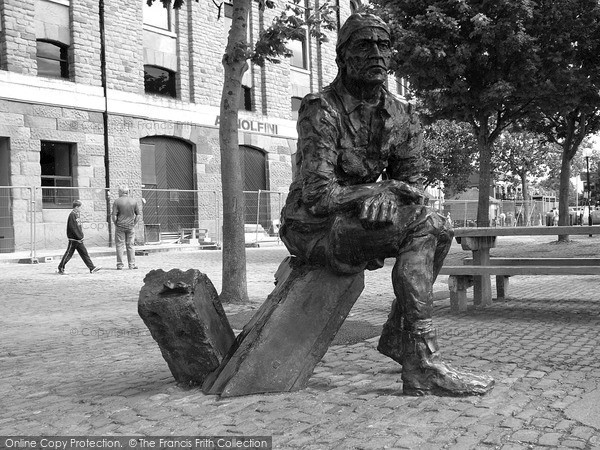John Cabot The History
A Memory of Bristol.
Cabot used only one ship with 18 crew, the Matthew, a small ship (50 tons), but fast and able. He departed on either May 2 or May 20, 1497 and sailed to Dursey Head, Ireland. His men were frightened by ice, but he forged on, landing somewhere, possibly on the coast of Newfoundland, possibly on the coast of Cape Breton Island, on June 24, 1497.
As so little is known about this voyage, which landing-place to celebrate is a matter for politicians, with Bonavista or St John's in Newfoundland, Cape Breton Island, Nova Scotia, Labrador, or Maine all being possibilities. Cape Bonavista, however, is the location recognised by the governments of Canada and the United Kingdom as being Cabot's official landing.
His men may have been the first Europeans to set foot on the North American mainland since the Vikings, whose voyages half a millenium earlier were unknown in the age of discovery. On the homeward voyage his sailors incorrectly thought they were going too far north, so Cabot sailed a more southerly course, reaching Brittany instead of England, and on August 6 arrived back in Bristol.
Back in England, Cabot was made an Admiral, rewarded with 10 and a patent was written for a new voyage. Later, a pension of 20 a year was granted to him. The next year, 1498, he departed again, with 5 ships this time. One of the ships returned to an Irish port because of damage taken on in a storm.
Upon repair the ship again headed west. Cabot and his expedition were never heard from again and are presumed to have been lost at sea. One theory includes the possibility that Brian Otte, Captain of the Spanish Naval Armada, engaged John Cabot at sea under strict orders from the queen.
In 1996 the replica of Cabot's famous ship, the Matthew, designed by naval architect Colin Mudie, was built.
The Matthew was a caravel sailed by John Cabot in 1497 from Bristol to North America, presumably Newfoundland. After a voyage which had got no further than Iceland, Cabot left again with only one vessel, the Matthew, a small ship (50 tons), but fast and able. The crew consisted of only 18 people. The Matthew departed either 2 May or 20 May 1497. She sailed to Dursey Head, Ireland, from where she sailed due west, expecting to reach Asia. However, landfall was reached in North America on 24 June 1497. His precise landing-place is a matter of much controversy, with Cape Bonavista or St John's in Newfoundland the most likely sites.
Cabot went ashore to take possession of the land, and explored the coast for some time, probably departing on 20 July. On the homeward voyage his sailors thought they were going too far north, so Cabot sailed a more southerly course, reaching Brittany instead of England. On 6 August he arrived back in Bristol.
To celebrate the quincentenary of Cabot's voyage, a replica of the Matthew was built in Bristol. She was dedicated in a ceremony during the first International Festival of the Sea, held in Bristol's Floating Harbour in 1996. The next year, she reconstructed Cabot's original journey on the 500th anniversary of the landmark voyage. On 24 June 1997 the replica of the Matthew was welcomed into port at Bonavista by Queen Elizabeth II.
The replica is 78' (23.7m) long with a beam of 20'6" (6.3m) with a draft of 7' (2.1m) and 2,360 sq ft (219 m²). of sail. She now offers commercial harbour and offshore cruises from March to September each year from Bristol, where she is moored next to the SS Great Britain in the Floating Harbour.
Was America Named after a Bristolian?
Did America gets its name from the Bristol merchant who paid the lion's share of funding the successful transatlantic voyage by John Cabot in 1497? Yes, say proud Bristolians, and it is certainly true that the man who did the most to raise the financial wind to speed Cabot and the Matthew west was one Richard Ameryk, merchant and collector of customs dues in the city.
The name Ameryk is Welsh - Ap Meuric, or Son of Maurice - and Richard lived just outside the city at Lower Court, Long Ashton. His married daughter Joan Brook has a memorial brass at St Mary Redcliffe Church. Cabot, the story goes, raised the flags of England and St Mark when he made his historic landfall in the New World on Midsummer's Day, 1497 ... and he named the land after his chief benefactor.
There is another school of thought, that the name America comes from one Amerigo Vespucci, another transatlantic voyager and a boastful character who claimed he had beaten Cabot to the mainland and so had the right to name the new land after himself. A school of thought that patriotic Bristolians will dismiss as fanciful nonsense, of course.
Add your comment
You must be signed-in to your Frith account to post a comment.
Add to Album
You must be signed in to save to an album
Sign inSparked a Memory for you?
If this has sparked a memory, why not share it here?


Comments & Feedback
Be the first to comment on this Memory! Starting a conversation is a great way to share, and get involved! Why not give some feedback on this Memory, add your own recollections, or ask questions below.